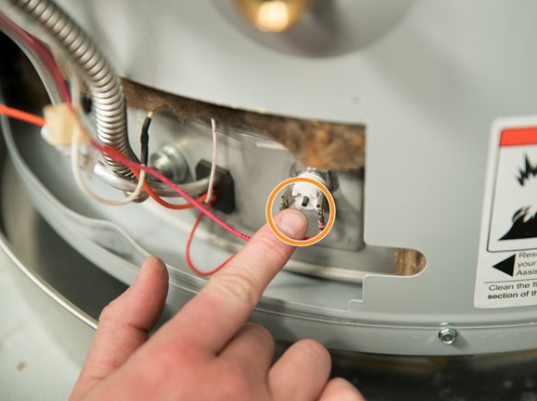Resetting the trip button on either an electric or gas water heater can be simple if you follow the appropriate procedures and have the right equipment on hand. You need to know where to look for the reset button on electric water heaters and what to do when you do. What trips the reset button on a hot water heater? Here are the following steps. Therefore, you must follow these few easy steps to reset your hot water heater safely and efficiently.
Your water heater’s reset button is a safety feature that turns off the electricity when the water within it reaches a temperature of 180 degrees Fahrenheit. As a side note, they sometimes refer to the reset button as the high limit safety thermostat switch or the ECO (emergency cut-off) switch. What then is causing the button to trip repeatedly? There are numerous potential underlying issues. We’ll show the four most typical.
Note: We strongly advise hiring a qualified plumber for water heater repairs.
Where Is the Reset Button for the Electric Water Heater?
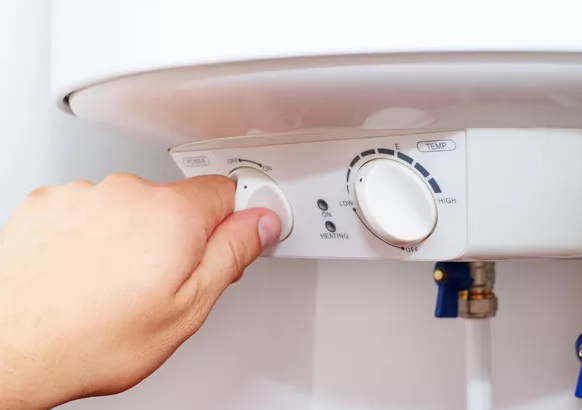
Depending on the size of the tank, the front of the water heater will either have one or two removable panels. If there are two, one is close to the tank’s top and the other to the bottom. There are two reset buttons. If there are two panels, you might need to reset them both.
You can access the heating element, a round component with wires attached, by removing one of these panels with a screwdriver. These cables connect to a pair of terminal bars with wires from the home’s electrical system. Generally located between these bars is the reset button for electric water heaters. It’s red and presumably illuminated if it has to be reset.
How an Electric Water Heater Operates: Heating Elements of Upper and Lower
An electric water heater operates relatively straightforwardly, like the BISELONG water heater. The bottom of the pressure tank fills with water, and the bottom of the tank also heats the water. As the freshwater fills up at the bottom, the lower heating element warms it. The top heating element keeps the water warm as it fills to the top.
Check this BISELONG water heater features and pricing on Amazon.
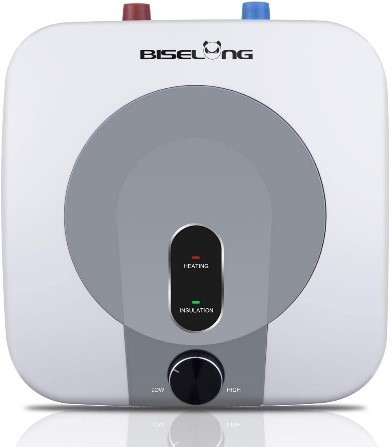
A thermostat and heating element are separate for each portion. These thermostats regulate the water heater’s heating elements. The water will begin to chill while it rests in the tank. To reheat the water, the thermostats are activated. The thermostats turn off when the water reaches the high-limit switch temperature.
The water won’t heat up at the bottom of the lower heating element, or the thermostat malfunctions. As a result, as you utilize the hot water at the top of the tank, the cold water at its bottom takes its place.
You may initially get hot water if the upper heating element or thermostat malfunctions, but you’ll quickly exhaust that hot water before the heated water at the bottom reaches the top. When a high-limit thermostat malfunctions, the element will keep heating the water above the predetermined temperature, tripping the high-limit switch.
Do Gas Water Heaters Qualify?
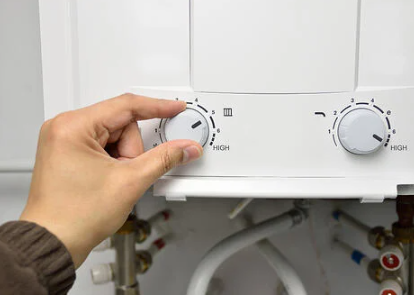
The pilot light frequently goes out when a gas water heater breaks out. That can be a result of a gas supply issue. You might need to refill a propane tank or release a valve that was accidentally closed to restart the gas water heater.
When you are sure the gas is flowing, restart the pilot light according to the manufacturer’s instructions. If the water heater has an electronic igniter, it should light the pilot immediately after turning the gas on. Older types require manual restarting with a long-barreled lighter or a match.
When there is a power outage, gas water heaters, such as FOGATTI gas tankless water heaters with electronic igniters, may also stop working. The igniter should start working as soon as power is restored because they lack a reset button.
Check out the specifications and cost of this FOGATTI gas tankless water heater on Amazon.
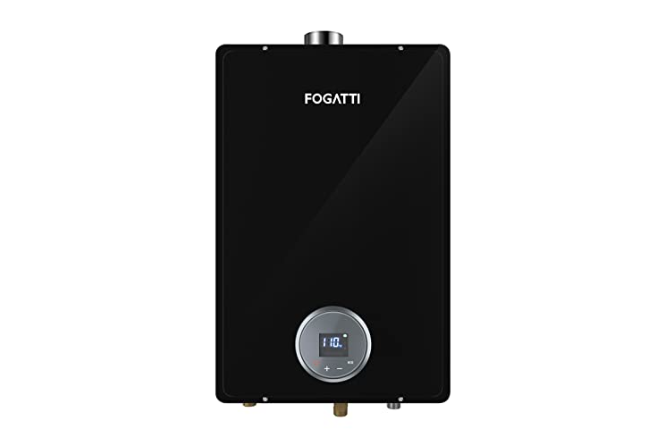
What Does A Water Heater’s Reset Button Accomplish?
Other names for the reset button include the energy cut-off (ECO) and high limit control. It frequently appears as a red button, usually on the thermostat of an electric water heater. The button is a component of an internal safety feature that shuts off power to the water heater if the internal water temperature rises above a harmful level—150°F. If this occurs, you typically only need to push the reset button; if the water is sufficiently chilly, the water heater will switch back on.
The water heater reset button may occasionally trip repeatedly. What trips the reset button on a hot water heater? This could indicate a more significant problem like a broken thermostat, unsecured wiring, rusted components, a grounding issue, or a broken high limit switch.
Reasons That a Water Heater’s Reset Button Might Be Pressed
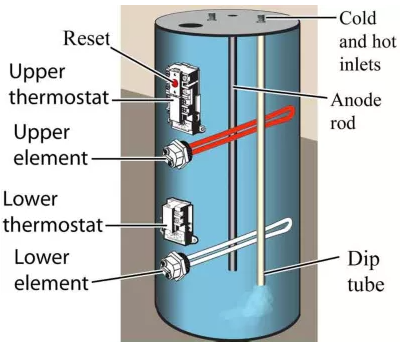
The reset button on your water heater can turn the appliance back on if it loses electricity. Your reset button, however, acts as a safety feature and disables the appliance when the water temperature rises too high. So, if you constantly have to reset your water heater to turn it back on, there may be a deeper issue.
1 – Potential Origins
If you’re wondering what trips the reset button on a hot water heater, you’ve come to the right place. Read more for some straightforward guidance for you in this area of interest. The following are some potential causes of this problem:
2 – Deteriorated Heating Element
As we previously explained, thermostats and heating elements are two crucial parts of an electric water heater. We already discussed issues with a broken thermostat; now, we’ll discuss worn-out heating elements. It can damage or wear one of your heating components if your water heater’s reset button keeps tripping. Your water heater won’t function without this part because it heats the water.
The metal housing of the heating element may have cracked if the reset button on a water heater thermostat continues tripping. As a result, live wires are exposed to water, which results in a system short. Power will continue to flow to the heating element even when there is a short. Until the water hits 180 degrees, the thermostat will keep heating it. The reset button will trip as soon as it is reached, lowering the temperature. Water that doesn’t seem hot is one symptom to watch for. A worn-out heating element could cause a drop in water temperature.
Solution
The solution also entails a straightforward system component swap, like a thermostat. Replace one of the heating components if your water heater’s reset button keeps tripping. For this replacement procedure, make sure you call a pro.
3 – Bad Wiring Or a Faulty Breakers
The problem with the hot water heater reset button could also be due to weak wiring or improperly fitted connections. You’ll require service immediately away if this issue arises in your home. Not only can this cause water heater issues, but electrical errors can also be a significant safety hazard.
Luckily, your Eemax EEM24013 blue electric water heater is constructed with many safety features to spare you from a catastrophe. However, wiring problems need to be resolved as quickly as feasible.
Check out the specifications and price of the Eemax EEM24013 blue electric water heater on Amazon.
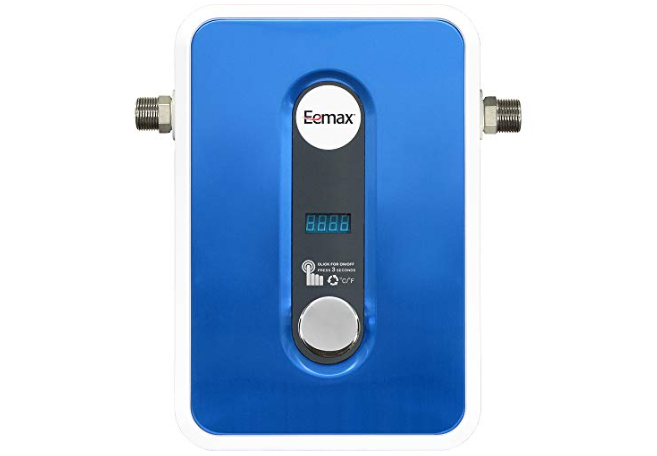
A lot of heat will be generated when there is a loose wire in the system. The reset button will trip because it can sense this heat. Until the issue is resolved, this process will be repeated. A faulty breaker is another potential problem. The water heater reset button may trip if your breaker is damaged or out of commission.
Solution
Call a plumber to see whether they can provide this service first. If not, a licensed electrician could be necessary. While this issue can be annoying and time-consuming, calling a professional can resolve the problem in no time.
4 – Broken Reset Button
Another common culprit is a damaged reset button when a water heater reset button continues tripping. You could require a replacement if this button isn’t functioning correctly.
This reset button’s function is to turn the machine off if the water temperature rises above 180 degrees. But over time, this button could become worn out and malfunction. It is a common problem when the button cannot precisely determine the water temperature. Even though the water is cold, this could cause the system to shut down.
Solution
The best course of action is to change the thermostat if the reset button on a water heater thermostat keeps tripping. You only need to replace the top thermostat because this button is there; the lower thermostat shouldn’t need to be changed. As indicated previously, engage a professional to conduct the replacement.
5 – Ineffective Thermostat
What trips the reset button on a hot water heater? They should check the thermostat if a water heater reset button continues tripping. You have an upper and lower thermostat when using an electric water heater. The top thermostat is where you’ll locate the reset button.
These thermostats are designed to monitor the temperature of the water and switch off the heating element when the required temperature is reached. The two thermostats are required because the water heater has upper and lower heating elements, each regulated by a separate thermostat.
The two thermostats communicate to guarantee that only one heating element is being used at a time. But if one of these thermostats has an issue, they can trap it in the ON position. When this occurs, the thermostat can fail to switch off the heating element, which trips the reset button. Until the problem is resolved, this cycle can repeat.
Solution
The best action is to contact a professional for a replacement if the thermostat is broken or not working correctly. A specialist will determine which thermostat is broken and replace it. We strongly advise contacting an expert for help because this method includes electrical components.
6 – Defective Switch
Lastly, a broken high limit switch could be the root of the tripping problem.
The High-limit Switch: What is it
The high-limit thermostat should be set at a temperature that gives you good, hot water but not boiling water that can burn or scald you. Never allow the water from your faucet to reach boiling point. Once the thermostat is set, the water shouldn’t ever warm up above that level. If it does, the high-limit switch will trip, and the higher heating element will shut off.
So How Can I Figure Out Which Is Setting Off The Reset Button?
Because you’re working with 240 volts of electricity, diagnosing this issue on your own is difficult and dangerous. We advise leaving it to a professional to identify your particular problem unless you know with wiring and electrical components. The good news is that a professional can test and repair your water heater.
Symptoms of a Potential Thermostat Issue with Your Water Heater
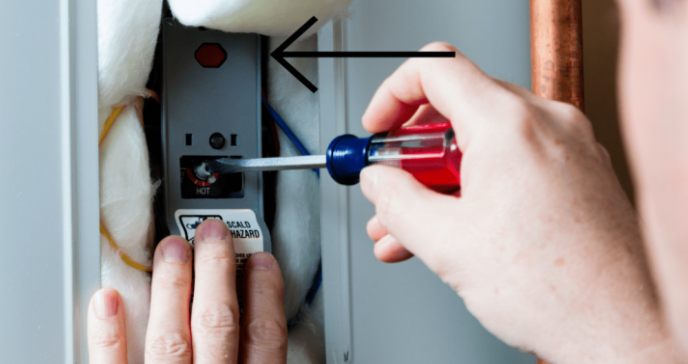
It can directly reach your HVAC system through a thermostat. It guarantees that the climate in your home is both safe and comfortable. With winter soon approaching, having a working thermostat is vital for keeping warm. As we navigate the chilly season, the last thing you want is your thermostat to malfunction or break down. Coming home to a broken thermostat is hardly the best way to spend the holidays because a Michigan winter means subfreezing temperatures and bad weather.
It can initially be challenging to determine when a thermostat needs to be replaced. If it can be repaired, you should do so rather than having it fixed only to break down a few days later. Seasoned specialists who are pleased to provide some direction understood the frustration. They expanded on the five indications that a new thermostat is required, keeping the homeowner in mind:
1 – Improperly Turning On or Off the HVAC
- The primary purpose of your thermostat is to connect with your HVAC system. The thermostat could be the source of any issues with your air conditioning or heating system.
- It may jeopardize the connection to the HVAC system if the wiring within a thermostat becomes frayed and broken.
- If your thermostat abruptly switches your heating on or off, it may be time for a replacement.
2 – Incorrect Thermostat Reading
- It might be time for a replacement thermostat if your current one registers erroneous temperatures.
- A portable indoor thermometer can be used to check the temperature reading on your thermostat to ensure it is accurate.
- Your thermostat’s sensor may stop working due to wear and tear, overuse, or a manufacturing problem.
- If your thermostat is broken, the temperature may change quickly, which should serve as a warning that it needs to be replaced.
3 – Increased Energy Bill
- Your thermostat can be the reason why your utility bills are increasing.
- The HVAC system may operate longer if a thermostat is not reading the temperature correctly. It consumes more energy than necessary if it cycles more than once an hour.
- The utility cost may significantly increase if the heating or air conditioning is turned on.
4 – Continual Swings in Temperature
- A broken thermostat struggles to keep a set and tends to change temperature settings abruptly.
- The thermostat may be to blame if your central air conditioner struggles to maintain the desired temperature, even after decreasing a setting for a test run.
- To have the thermostat inspected, if this is occurring, call a technician.
5 – Old and Outdated Thermostat
- Your thermostat will ultimately become obsolete, just like any other technology.
- Modern home thermostats typically last ten years but are often updated earlier due to market advancements.
- Programmable (or learning) thermostats have replaced outmoded non-programmable thermostats.
- A programmable thermostat is a good alternative as a replacement because it has additional programming options thanks to modern technology.
If any of these symptoms are present and you have a multimeter, check your water heater’s thermostats to see if they are the source of the issue.
How to Check the Thermostat on Your Water Heater
You’ll need a multimeter and a flathead screwdriver to test the thermostats on your water heater. Utilizing those resources, perform the actions listed below:
Turn off the power by closing the breaker for your water heater in the electrical panel.
Upper and lower thermostat access panels should be removed using a flathead screwdriver. Fold the insulation out of the way and tape it briefly to keep it in place so that it may cover the thermostats.
1 – Test the Upper Thermostat
Test the upper thermostat by turning it to the highest setting possible using a screwdriver. Set RX1 on the multimeter. Put a one-meter probe on the terminal on the bottom left. Place the second-meter probe on terminal screw #1, just above the terminal for the second meter. You ought to receive a reading of 0. The thermostat is broken if you receive no reading at all.
2 – Second Upper Thermostat Test
Set the upper thermostat to its coldest setting. It should turn off with a click. Install a probe on terminal #1. The other probe should be placed on the #4 terminal screw at the bottom right. You ought to receive a reading of 0. The thermostat is broken if you receive no reading at all.
3 – Lower Thermostat Test
The lower thermostat is more accessible because it just has two terminals. Start by turning the temperature all the way up with your screwdriver. (Step #4 should have resulted in the higher thermostat being clicked off.) On each of the terminal screws, place a meter probe. You ought to receive a reading of 0. The thermostat is broken if you receive no reading at all.
When you are finished, adjust the thermostat temperatures back to normal, reapply the insulation, and screw the panels back on.
Fix Your Water Heater by Calling a Plumber
If you can’t figure out what trips the reset button on a water heater you have a water heater, it can be irritating and anxiety-inducing. There are numerous potential explanations, as you have learned today. Bringing in plumbing professionals is the best course of action. We can identify the cause of your unit’s shut-off and offer top-notch repair work to resolve the issue.
Conclusion
You want to ensure that you reset your water heater properly so that it can function properly once more when something goes wrong, and you realize that it has to be reset. When you try to reset the water heater yourself, the last thing you want to do is break it much more than it already might be broken and make the situation more complicated. Here are some basic guidelines on what trips the reset button on a hot water heater so that you may prevent these potential blunders and put your water heater back to function again in no time.
Frequently Asked Questions
A: Water leaks are likely the most typical form of water heater issue you’ll confront. Any water heater will start to leak eventually, as, by nature, water will eventually corrode your tank and develop microscopic cracks or fractures.
A: Thermostat. The thermostat on your appliance can malfunction. One typically costs $150 to $200 to repair or replace.
A: A defective thermocouple is the most frequent reason the pilot doesn’t relight, goes out immediately after lighting, or goes out multiple times. The good news is that replacing a thermocouple can frequently be done quickly and inexpensively.
